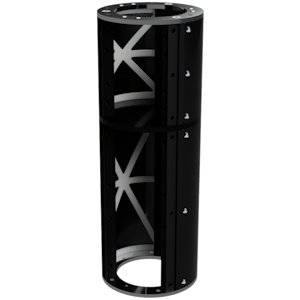
Aerostructure
During flight, the rocket experiences extreme forces. The Aerostructure compensates all shocks from launch to recovery without bending, breaking or losing a nose cone.
The inner structure of the rocket transfers most forces. It serves as the connection point for every component. The structure is made from light weight carbon rods and aluminium connectors. For ease of transportation, the rocket can be completely assembled by connecting these axial aluminium discs, dubbed raydon’ts. Since we have access to the inside of the rocket next to all raydon’ts, no classical Radial-axial-connectors are needed. To obtain dimensions for key components, we combine results from material tests and FEM simulations.

To access the propulsion system, Avionics, Payloads and more, glass fiber panels cover most of the outside of our rocket. After gaining experience with glass fiber during the last projects, we continue to optimize our manufacturing processes for more precise results. Since sunshine in Portugal is no guarantee, sealing against rainwater is especially important close to our Avionics components.
Continuing our idea from FRoDO-M, our fins have the option to integrate PCBs for LED singnals and additional sensors. In previous the project, we collected fin-fluttereing data. Light-up fins helped us recover our rocket and moniture its status before launch. Instead of flat surfaced fins we are now develpoing a manufacturing process for airfoils with integrated PCBs.
Ensuring that the rocket is within the stability margins during the entire flight and EuRoC’s pre-launch tests is a key priority for the aerostructure team. To obtain reliable results, simulations provide more insights.
Simulation
What stresses will the vehicle experience during flight? Do certain components perform the way we intend? What touchdown velocity do we achieve? To answer these and many other questions, we carry out a number of different simulations. These can be grouped into four broad categories.
Firstly we have Flight Simulations. They simulate the entire flight from ignition until touchdown. We currently use RocketPy to determine all important flight characteristics like overall flight time, stability margins, velocities, apogee altitude and many more. For these flight simulations, we need a lot of data and results from the other simulation types, like the masses of modules/components, thrust characteristics of our motor, drag influence on the vehicle, etc.
Secondly we employ Aerodynamic Simulations. These help use determine the drag and lift of certain components. For this, we mainly use RasAero II and xflr5/xFoil, as well as various cfd programs. Using these results, we evaluate the recovery concept as well as optimize our vehicle’s stability while minimizing the drag losses.
We also use Structural Simulations. To assist in designing components and to verify that components can withstand the stresses during flight, we use Ansys as well as the integrated FEM tool in Autodesk Fusion.
Lastly, we utilize System Simulations. These are used to simulate the dynamic behavior of (sub-)systems of our rocket, for example the fluid system for our hybrid propulsion system as well as the recovery system. For this application, we use Matlab/Simulink.

